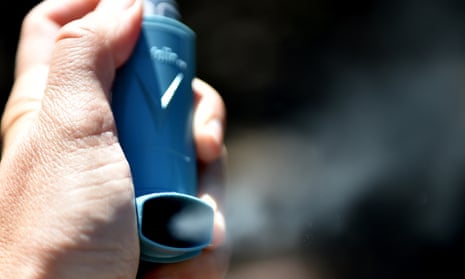Melburnians and western Victorian residents with asthma and hay fever have been urged to carry inhalers or stay inside as large asthma storms move across the state, while Canberra residents have been told to be on alert for later in the week.
The Victorian health department has warned that regions in the state’s west could experience an epidemic thunderstorm asthma episode on Wednesday as winds pick up a huge volume of grass pollen.
The #thunderstormasthma forecast is HIGH for parts of Victoria tomorrow. Do you have asthma or hay fever? Are you prepared? For advice https://t.co/tibl9plF9b pic.twitter.com/HHsdpNKsia
— VicGovDHHS (@VicGovDHHS) November 10, 2020
The warning for metropolitan Melbourne has been listed as “moderate” while vulnerable residents in the south west, Wimmera, Mallee and northern country regions have been told they are at high risk and should stay indoors where possible.
Warnings on the Victorian emergency website have urged people at heightened risk, including people with asthma or anyone who regularly suffer from hay fever, to have an action plan, carry reliever medication where appropriate, and seek medical advice if they begin to develop asthma symptoms.
Please share this important community message.
— Ambulance Victoria (@AmbulanceVic) November 9, 2020
If you suffer from asthma or hay fever, please make sure you're prepare for the predicted storms this week. Have your medication handy and stay indoors.
❤️💙 pic.twitter.com/78662TVSJM
The Australian Capital Territory’s health directorate also issued a warning, saying the region would experience conditions leading to an increased risk of thunderstorm asthma on Thursday and Friday.
ACT residents who suffer from hay fever or asthma are warned to be vigilant and monitor any worsening of their condition, and to avoid being outside or having their windows open either during a thunderstorm or in the wind gusts that come directly before the thunderstorm.
Thunderstorm asthma is caused by high amounts of grass pollen in the air and a particular type of thunderstorm. This combination can cause tiny pollen particles to embed deep in people’s lungs, causing a dangerous asthma-like reaction.
The fear in widespread, or epidemic, episodes of thunderstorm asthma is that a huge surge of people requiring medical help could overwhelm hospital or ambulance systems. This occurred in November 2016, when thousands of people developed breathing difficulties over a very short period, causing a 672% rise in respiratory-related presentations to Melbourne and Geelong public hospitals. Ten people died as a result of the storms.
The health department has also urged Victorians not to assume that symptoms such as a running nose, sore throat or coughing are related to the storm, and to get tested for Covid-19 if they have “symptoms that are in any way different to your usual hay fever or asthma symptoms”.
They have asked anyone who is unsure about their symptoms to also have a coronavirus test.
The asthma storms are set to clear in Victoria on Thursday, with the entire state returning to the low risk category.
Wild weather has also affected South Australia with more than 32,000 properties left without power after storms lashed the state, and 300,000 lightning strikes were reported over a wide area.
South Australia has been smashed by a staggering 400,000 lightning strikes, sparking dozens of fires and blackouts. From the city to the Barossa and Glenelg, the Hills and Yorke Peninsula, no corner of our state was left untouched. https://t.co/zlTMTvySC4 @elspethhussey7 #7NEWS pic.twitter.com/biUthbxYPt
— 7NEWS Adelaide (@7NewsAdelaide) November 11, 2020
SA Power Networks said its crews were continuing to return services on Wednesday morning to customers across the Adelaide Hills and the mid-north, on Kangaroo Island and in the south-east.
Lightning strikes also caused a number of scrub fires, with blazes on Yorke Peninsula prompting the Country Fire Service to issue a watch and act warning for towns including Minlaton, Edithburgh, Cabowie, Yorketown and Stansbury. Those warnings were later downgraded to a bushfire advice message.
A severe weather warning was issued at one stage for large areas of SA, from the far west stretching through the mid-north and across the Adelaide Hills, but conditions had moderated by Wednesday morning.
